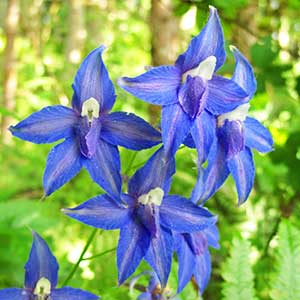Delphinium trolliifolium
Delphinium
Columbian larkspur, cow-poison, poison delphinium, poison larkspur
delphinium, larkspur
(40-)60-120(-180) cm;
base usually reddish, glabrous to puberulent.
blade ± pentagonal, 4-8 × 7-16 cm, margins ± incised, nearly glabrous; ultimate lobes 0-9, width 15-30 mm (basal), 5-20 mm (cauline), widest at middle or in proximal 1/2.
blade deeply palmately divided, round to pentagonal or reniform, margins entire or lobes apically crenate or lacerate, lobes of basal blades wider and fewer than those of cauline blades.
(5-)14-40(-75)-flowered, ± open, at least 2 times longer than wide;
pedicel 1-4(-9) cm, puberulent to glabrous;
bracteoles (2-)6-12 mm from flowers, green, linear, 5-9(-14) mm, puberulent.
terminal, 2-100(-more)-flowered racemes (occasionally branched, thus technically panicles), 5-40 cm or more;
bracts subtending inflorescence branches;
pedicels present or absent;
bracteoles (on pedicels) subopposite-subalternate, not forming involucre.
sepals dark blue, glabrous, lateral sepals spreading, (8-)14-21 × 5-9 mm, spurs straight or downcurved at apex, within 20° of horizontal, (10-)16-23 mm;
lower petal blades covering stamens, 5-10 mm, clefts 1.5-3 mm;
hairs sparse, mostly near junction of blade and claw, centered or on inner lobes, well dispersed, yellow.
bisexual, bilaterally symmetric;
sepals not persistent in fruit, 5;
upper sepal 1, spurred, 8-24 mm;
lateral sepals 2, ± ovate to elliptic, 8-18 mm;
lower sepals 2, similar to lateral sepals;
upper petals 2, spurred, enclosed in upper sepal, nectary inside tip of spur;
lower petals 2, plane, ± ovate, ± 2-lobed, clawed, 2-12 mm, nectary absent;
stamens 25-40;
filaments with base expanded;
staminodes absent between stamens and pistils;
pistils 3(-5), simple;
ovules 8-20 per pistil;
style present.
(15-)23-34 mm, 3.8-5.5 times longer than wide, glabrous.
follicles, aggregate, sessile, ± curved-cylindric, sides prominently veined or not;
beak terminal, straight, 2-4 mm.
unwinged;
seed coats smooth.
dark brown to black (often appearing white because of air in seed coat cells), rectangular to pyramidal, often ± rough surfaced.
= 8.
= 16.
Delphinium trolliifolium
Delphinium
Delphinium trolliifolium occurs in the northern Coast Range of California, the Columbia River Valley to just east of Mt. Hood, and the Willamette Valley of Oregon upstream to Lane County. California plants differ somewhat from Oregon plants in pubescence patterns and habitat preferences. Further study may show that two entities are involved here.
Hybrids between Delphinium trolliifolium and D. decorum, D. menziesii subsp. pallidum (D. ×pavonaceum Ewan, Peacock larkspur), D. nudicaule, D. nuttallianum, and D. nuttallii are known. Delphinium trolliifolium is likely to be confused only with D. bakeri. Refer to discussion under that species for differences.
(Discussion copyrighted by Flora of North America; reprinted with permission.)
Species ca. 300 (61 in the flora).
Three Eurasian species of Delphinium–D. elatum Linnaeus, D. grandiflorum Linnaeus, and D. tatsienense Franchet–have been commonly cultivated in North America. Of the nonnative taxa, only D. elatum is sporadically naturalized, as far as is known. Isolating mechanisms in Delphinium appear to be primarily ecological, geographic, and/or temporal. Where these distinctions are disrupted, introgression often exists. Hybridization occurs regularly between certain taxa, particularly in areas of disturbance (e.g., roadcuts, drainage ditches, clearcuts). The more common and easily recognized hybrids are included in the key.
Many names have been misapplied in Delphinium. The few misapplied names mentioned in discussions below refer to relatively widespread problems.
Unless otherwise noted, the key and descriptions refer to fresh material. Some features may be significantly altered by pressing; they can, however, usually be determined with a certain amount of effort and experience.
In the descriptions, "base of cleft" refers to the point where the cleft or sinus reaches most deeply into the petal blade.
(Discussion copyrighted by Flora of North America; reprinted with permission.)
1. Lower petal blades less than 1/5 length of lateral sepals; sepals never red or yellow. | Sect. Elatopsis |
1. Lower petal blades more than 1/5 length of lateral sepals; sepals blue, purple, white, red, or yellow. | Sect. Diedropetala |


